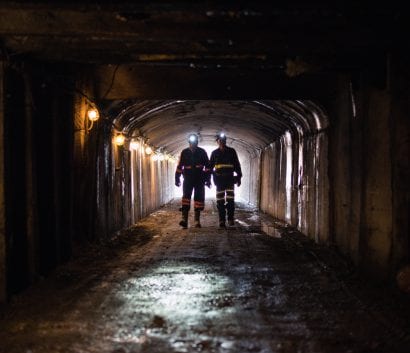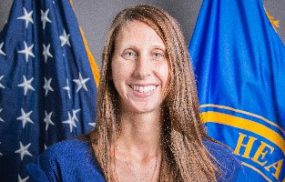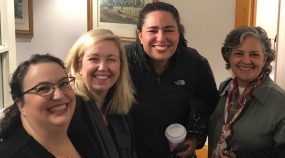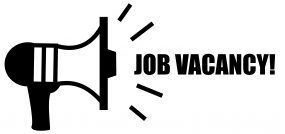eNews: Volume 20, Number 8 (December 2022)
Volume 20, Number 8 (December 2022)
From the Director’s Desk
John Howard, M.D. Director, NIOSH
National Miners Day: Reflecting on the Past, Appreciating the Present, and Embracing the Future
Today is National Miners Day, giving us a chance to reflect on how this vital industry benefits our lives. More importantly, it is a day to think of those who work in this challenging profession and face its hazards, with some help from NIOSH.
Lawmakers established the first Miners Day on December 6, 2009. The date is an observance of the anniversary of the Monongah, West Virginia, mining disaster where 362 miners died from a catastrophic explosion. It remains the highest death toll of any U.S. mining disaster.
Mining remains one of the most hazardous industry sectors, according to the Bureau of Labor Statistics. However, these hazards are often unseen because about half of the more than 12,000 mines spread across every state in the U.S. are in rural areas, and many are entirely underground.
The minerals, stones, metals, and other raw materials that come out of mines are usually transformed beyond recognition to make valuable goods. The cars we drive and roads we travel, the utensils and appliances we use to make our meals, and the mobile devices and computers we communicate with are all possible because mine workers delivered the raw materials needed to make these useful items.
The mine workers who deliver these resources face many potential hazards including noise, dust, shifting geology, poor illumination, repetitive motions in unusual positions, and working around enormous pieces of moving equipment. The training, technologies, and work practices to manage and eliminate these hazards play a critical role in their profession.
The NIOSH Mining Program’s rich history has roots in the former Bureau of Mines, and with its ongoing research, continues to contribute meaningful improvements to the way miners work and the methods by which mines can keep their workers healthy and safe. Since its inception in 1996, the NIOSH Mining Program has developed new technologies and made other contributions that include the following:
Advances in mining equipment:
- Cap lamp designs and brighter area lights reduce glare and help miners to see potential hazards more clearly
- Mobile dry scrubbers pull hazardous coal dust out of the air
- Intelligent proximity detection systems keep miners safe around moving equipment
- Continuous personal dust monitors empower coal miners with near real-time information about coal dust exposure
New apps and software:
- ErgoMine mobile app helps audit mining workplaces for potential ergonomic improvements
- EXAMiner hazard recognition software allows users to perform a virtual workplace examination to build confidence for real-life settings
- FAST software program supports field-based silica monitoring for quicker results than sending samples to a lab
- Ground Support Factor of Safety Calculator software aids in designing ground support in underground mining excavations
- S-Pillar software helps design stable pillars in stone mines
Safety innovations and training:
- Hearing loss simulator lets users experience what hearing loss sounds like and to avoid hazardous noise moving forward
- Innovations in enclosed cab equipment design keep hazardous dust out and away from miners in the cab
- Practical noise controls for several of the most hazardous noise sources in mining
- Dozens of guidelines, best practices, and training guides on topics such as hearing protection, refuge chamber use, slip-trip-fall prevention, workstation design, and dust control
The mining industry has come a long way since the Monongah disaster, but modern-day miners still face many challenges and risks, including new ones that come with changing technology and industry practices. NIOSH researchers are committed to helping miners meet these challenges so that all miners can go home to their families uninjured and healthy every day.
See the Mining Program’s website to learn more about the latest mining innovations and other NIOSH mining-related research.
Few Studies Address Fatigue’s Effects on Illness and Injury in Agriculture, Forestry, and Fishing
Fatigue can increase the risk of illness and injury among agriculture, forestry, and fishing workers. However, according to research recently published in the American Journal of Industrial Medicine, few studies measure this risk and how to prevent it.
Fatigue is a safety issue in many industries, including agriculture, forestry, and fishing (AgFF). This sector employs nearly 2.5 million workers, according to the Bureau of Labor Statistics (BLS). BLS data also show that compared with workers in all other industries, AgFF workers are over six times more likely to die as a result of a work-related injury. Yet, few studies have addressed the issue of fatigue and work-related illness and injury among AgFF workers.
To clarify what we know, along with areas for future study, NIOSH researchers reviewed 407 scientific studies published from 1990 through 2019. Of these, 96 met the study requirements to be in the final review. Agriculture made up more than two thirds of the included studies, while one fourth were in fishing or seafood processing and the rest in forestry.
Overall, the studies showed a relationship between fatigue and work-related illness and injury, but the extent of this relationship is unclear. Long hours—sometimes as many as 16 or more per day—appeared as a common theme across the studies. Similarly, working at night, or shift work, frequently occurred, especially among workers in seafood processing and forestry. Certain groups of workers faced a greater risk of fatigue-related injury, including those who were newly employed, older, younger, female, and born outside of the country. Working more than 40 hours a week also appeared to increase the risk. Despite the evidence linking fatigue to illness and injury in AgFF, few studies discussed interventions to help decrease the risk. While more research is needed to measure the effects of fatigue on injury and illness among AgFF workers, according to the researchers, there is a critical need to develop practical measures to manage fatigue in AgFF workplaces.
More information is available: Agriculture, Forestry, and Fishing Program | NIOSH | CDC
Five Occupations With the Highest Levels of Infection Early in the COVID-19 Pandemic
During the COVID-19 pandemic, the workplace emerged as a source of exposure to the virus that causes COVID-19. At the same time, the rapidly changing pandemic led to inconsistent information about which jobs had the highest levels of infection.
To learn more, NIOSH researchers examined the results of a nationwide, online survey administered by the Delphi Group at Pittsburgh’s Carnegie Mellon University. From September 8 through November 30, 2020, nearly three million U.S. adults responded to the survey via a Facebook banner. The survey identified those who had worked for pay outside the home in the previous four weeks and had ever tested positive for COVID-19. Because the surveys were conducted before COVID-19 vaccination was available, the results were not influenced by differences in vaccination rates between occupational groups.
According to the study, recently published in The American Journal of Industrial Medicine, the five major occupational groups with the highest test positivity (17%–14%) were in production, building and grounds cleaning and maintenance, construction and extraction, healthcare support, and food preparation and serving. Among detailed occupational categories, the six highest percentages of positive tests were for 1) massage therapist, 2) food-processing worker, 3) bailiff, correctional officer, 4) funeral service worker, 5) first-line supervisor of production and operating workers, and 6) nursing assistant or psychiatric aide. In these jobs, the rate of positive tests ranged from around 1 in 3 to 1 in 5 workers. The differences persisted even after controlling for additional factors such as age, gender, and other medical issues.
These results can help inform ongoing COVID-19 prevention efforts, evaluation of the impact of vaccination and new COVID-19 variants on work-related exposure, and responses to other contagious diseases.
More information is available: COVID-19 Information for the Workplace | NIOSH | CDC

Miners entering one of the research mines on the NIOSH Pittsburgh campus. These mines are used for convenient underground testing of new health and safety solutions before offering them to working miners. Photo by NIOSH.
Director’s Desk
Research Rounds
- Few Studies Address Fatigue’s Effects on Illness and Injury in Agriculture, Forestry, and Fishing
- Five Occupations With the Highest Levels of Infection Early in the COVID-19 Pandemic
Highlights
- NIOSH Announces New Deputy Director
- NIOSH Health Hazard Evaluation Program Celebrates 50 Years!
- New Study Details Work-related COVID-19 Exposure Among Non-healthcare Workers
- Investigating Inhalation Exposures and Respiratory Health in Coffee Workers
- Special Issue on Working Hours and Fatigue
- Upcoming Deadlines for Commercial Fishing Safety Research & Training Grants
- Nomination Period Extended for World Trade Center Health Advisory Committee
- NIOSH Congratulates
- Winners Announced for NIOSH Mine Safety and Health Technology Innovations Awards
- NIOSH Scientist Named One of the “100 Global Inspirational Women in Mining”
- NIOSH Scientist Receives Award for her Work in Reproductive Health
Monthly Features
John Howard, M.D., Director
Christina Spring, Editor in Chief
Managing Editor
Tanya Headley
Section Editor
Anne Blank, Research Rounds
Kiana Harper, Highlights & Monthly Features
Contributing Editors
Sarah Mitchell
Copy Editor
Cheryl Hamilton
Technical Support
Steve Leonard, Technical Lead
Steven Marra, Web Developer
To receive the NIOSH eNews email newsletter, enter your email address:
NIOSH Announces New Deputy Director
John Piacentino, MD, MPH, has been appointed as the new NIOSH Deputy Director for Program. Dr. Piacentino came to NIOSH in 2007 from the Occupational Safety and Health Administration. He served as a NIOSH Senior Scientist from 2007–2011 and then as the NIOSH Associate Director for Science from 2011 to present. Dr. Piacentino has a Doctor of Medicine degree from Temple University School of Medicine and a Master of Public Health degree from Johns Hopkins Bloomberg School of Public Health. Dr. Piacentino replaces Dr. Margaret Kitt, who retired in September. He will assume his new duties on January 1, 2023. Congratulations Dr. Piacentino
NIOSH Health Hazard Evaluation Program Celebrates 50 Years!
Fifty years ago, federal regulations gave the NIOSH Health Hazard Evaluation (HHE) Program the authority to conduct evaluations at workplaces to identify potential workplace hazards. Since 1972, the HHE Program has completed over 16,000 requested evaluations across all 50 states, the U.S. territories of Puerto Rico, and the U.S. Virgin Islands. The HHE Program has identified numerous new and emerging workplace hazards and prevention measures. You can learn more about the HHE Program and its 50 years of impact in the NIOSH Science Blog.
New Study Details Work-related COVID-19 Exposure Among Non-healthcare Workers
A new NIOSH study examines the differences in exposure to the virus that causes COVID-19 among people who worked outside of the home in non-healthcare settings. The study, recently published in Clinical Infectious Diseases, found that one in five workers surveyed reported being exposed to COVID-19 at work. Read the full NIOSH Update.
Investigating Inhalation Exposures and Respiratory Health in Coffee Workers
NIOSH researchers and partners recently published findings in Frontiers in Public Health from a series of investigations on the respiratory health effects from inhalation exposures in the coffee industry. The investigations show results from various studies about exposures, respiratory risks, and the use of effective engineering controls. This integrative approach can help to pave the way for more accurate health risk estimates and recommendations to improve respiratory health outcomes for workers.
Special Issue on Working Hours and Fatigue
The American Journal on Industrial Medicine just released a special issue on Working Hours and Fatigue: Meeting the Needs of American Workers and Employers. The issue has an overview on the benefits of nonstandard work hours, which include increased production time and the number of jobs. Journal editors include Imelda Wong and Naomi Swanson of the NIOSH Center for Work and Fatigue Research.
Upcoming Deadlines for Commercial Fishing Safety Research & Training Grants
NIOSH and the U.S. Coast Guard have $6 million available for commercial fishing safety research and training in 2023! The deadline to apply is January 31. Interested applicants can find the latest grant information on the NIOSH Commercial Fishing Occupational Safety Research and Training Program webpage. For questions, please contact Bridgett Garrett, NIOSH Scientific Program Official.
Nomination Period Extended for World Trade Center Health Advisory Committee
The World Trade Center Health Program is requesting nominations for candidates to serve on the Scientific/Technical Advisory Committee (STAC). Appointments to STAC are for up to 4 years. The frequency of committee meetings is determined by the WTC Health Program administrator based on program needs. Nominations are due by December 30. Further information on how to submit nominations is available on the NIOSH docket website.
NIOSH Congratulates
- Winners Announced for NIOSH Mine Safety and Health Technology Innovations Awards
The NIOSH Mining Program, in conjunction with the Essential Minerals Association, the National Mining Association, and the National Stone, Sand, and Gravel Association, selected four organizations in their respective industry sectors. The winners were recognized for developing new safety equipment and systems, for employing new technology, or for cleverly reconfiguring a worksite to gain health and safety advantages. For more information on the winners, see the NIOSH Update.

- NIOSH Scientist Named One of the “100 Global Inspirational Women in Mining”
NIOSH Research Health Scientist Dr. Emily Haas was selected as one of the “100 Global Inspirational Women in Mining” for 2022. Every two years, Women in Mining UK recognizes 100 women across all roles, seniorities, and jurisdictions who have made inspiring contributions towards a stronger, safer, and more sustainable mining industry. Dr. Haas was one of 491 candidates nominated from 61 countries for the 2022 edition. Photo courtesy of Dr. Emily Haas.

- NIOSH Scientist Receives Award for her Work in Reproductive Health
Dr. Carissa Rocheleau recently received the 2022 Champion for Knowledge award by Cradle Cincinnati, an organization dedicated to reducing infant mortality. Dr. Rocheleau is a reproductive occupational epidemiologist at NIOSH. In this role, she collaborates with pregnant workers and employers to reduce hazardous occupational exposures during and after pregnancy. She has also spent years promoting the collection of occupational data for pregnant workers, leading to the inclusion of this information in several large, national surveys such as CDC’s Pregnancy Risk Assessment Monitoring System survey. Pictured from left to right: Carissa Rocheleau, Kristen Van Buren, Amel Omari, and Tina Lawson. Photo courtesy of Carissa Rocheleau
New Communication Products & Reports
CASE Reports
FACE Reports
- A Farm Laborer Died After He Was Caught in the Rotating Feed Roller of a Brush Shredder—California
- A Maintenance Diver Died From Hyperthermia as He Was Preparing to Do Routine Maintenance on a Water Tank—California
- Delivery Driver Crushed by Granite Slab— Kentucky
- Forklift Operator’s Arm Crushed by Mast—Washington (slideshow)
- Groundskeeper Crushed When UTV Tips Over—Washington (slideshow)
- Mechanic Service Technician Fatally Struck by Order Picker Carriage—New York
- Occupational Fatalities in Kentucky, Annual Report 2021
- Trooper Struck by Vehicle While Investigating Crash On Interstate Highway—Oklahoma
Program Performance One-Pagers (PPOPs)
NIOSH Science Blog
Sign up to have notifications about new NIOSH Science Blogs delivered directly to your inbox! Here are the blogs from November:
- Celebrating the 3rd International Symposium to Advance Total Worker Health®
- Total Worker Health® Symposium: A Closer Look at Keynotes
- Construction Helmets and Work-related Traumatic Brain Injury
- NIOSH Rising Stars
- The Risk of COPD is Increased for Workers in Certain Industries and Occupations and With Certain Occupational Exposures
- Worker Well-being Takes Center Stage: Fireside Chat With the U.S. Surgeon General
- Promoting Partnerships to Explore the Impacts of Technological Change on Work and Well-being
- Protecting Temporary Workers: Best Practices for Host Employers
Federal Register Notice
Solicitation of Nominations for Appointment to the World Trade Center Health Program Scientific/Technical Advisory Committee (WTCHP-STAC); Amended Notice of Solicitation of Nominations
The notice was posted on October 13. Comments must be received by December 30.
Advisory Board on Radiation and Worker Health, Subcommittee for Procedures Reviews, National Institute for Occupational Safety and Health (NIOSH)
The notice was posted on November 28. Comments must be received by February 9, 2023. The meeting will be held on February 16, 2023.
Proposed Data Collection Submitted for Public Comment and Recommendations: Respiratory Protective Devices
The notice was posted on November 28. Comments must be received by January 27, 2023.
NORA
Steps for Improving the Safety and Health of Temporary Workers
The American Society of Safety Professional’s (ASSP) “Case for Safety Podcast” recently featured a discussion on the NIOSH guidance document Protecting Temporary Workers: Best Practices for Host Employers. You can listen to the podcast, which was created in partnership with NIOSH, ASSP, and the American Staffing Association.
News from Our Partners

CDC Seeks Director for National Center for Environmental Health
As the director of this center, the incumbent’s duties will include leading and managing the various environmental health program areas to achieve the goals and objectives of the center and its agency. They will also advise the state of the science in their respective field and program through intramural and extramural research and development. Applications are due by December 15. Find more information about the job or apply through the following links: applicants with a degree with a major study in an academic field related to the medical field, health sciences, or allied sciences should apply here; applicants with a Doctor of Medicine, Doctor of Osteopathic Medicine, or equivalent should apply here.
Safety and Health Training for Community Health Workers
The Harvard Chan Education and Research Center outreach program has launched a six-session occupational safety and health training for community health workers (CHWs) associated with the Childhood Lead Poisoning Prevention Program of the Massachusetts Department of Public Health. This training is unique in that the trainee group includes both CHWs and lead inspectors. In Massachusetts, CHWs visit homes and provide an orientation to the lead inspection process before the lead inspector’s visit. Including both roles in the training greatly increases the potential for collaboration, synergy, and safety for the lead inspection program.
Join the Society for Total Worker Health!
The Center for Health, Work & Environment is leading the launch of the Society for Total Worker Health™, which now has over 125 members. Join as a founding member by registering before January 1, 2023. The group’s mission is to collaboratively advance the field of Total Worker Health (TWH) through sharing knowledge and best practices for the benefit of working people, their families, organizations, and the community. Join the mailing list to receive updates on society activities and relevant TWH news.
Conferences, Meetings, Webinars, & Events
This page provides a list of publicly available occupational safety and health-related conferences, meetings, webinars, and events sponsored by NIOSH as well as other government agencies, and nongovernment agencies, such as universities, professional societies, and organizations.
